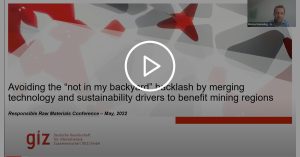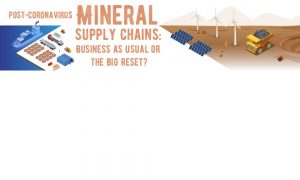
Miércoles 16 de marzo del 2022
Financial modelling in the extractive sector
Financial models are used by big companies to assess cashflows, profitability, payback periods, investment planning and fiscal regimes. Nevertheless, this powerful tool is not often used by small businesses or companies, exposing them to fluctuations in commodity prices, contingencies, and other financial challenges. Without a financial expert, these models are not always easy to apply. Within the mining sector, the FAST[1] and the FARI[2] standards have been developed to standardize and simplify efforts.
The importance of small-scale mining
Mining is an important economic activity for many developing countries, and artisanal and small-scale mining (ASM) also plays a key role in the extractive sector. According to Delve database,[3] in 2020 there were 44,75 million people across 80 countries that work in the ASM sector. If indirect employment figures are considered, this number rises to 134 million. According to the same source, ASM produces 20% of the global supply gold, 25% of diamonds and 80% of sapphires. These numbers give a sense of the importance of ASM.
Collaborative schemes between ASM and large-scale mining (LSM) also can be found with successful outcomes[4]. Within the ASM sector most countries differentiate between artisanal activities and small activities, mostly based on the level of production, surface of concession, machinery or tools used, mineral exploited and exploitation techniques. For example, in Peru, the mining law[5] defines on its article 91 the criteria and differences between small scale miners and artisanal miners. Similarly, in Colombia the classification is defined in the regulatory body[6].
Within the Andean region small-scale mining represents a significant amount of gold production. In Bolivia, according to the national statistics office (Instituto Nacional de Estadística) the gold production of small and cooperative mines in 2020 amounted to 2,6 tonnes[7]. In Ecuador, the small-scale mining concessions in 2021 made up 68% (985 of 1459) of total mining rights. In Peru, according to Energy and Mines Ministry, there are 3561[8] small-scale mines making up 32% of total mines. In Colombia, according to the latest mining census[9], 72% of the 14357 mining operations are small-scale mines[10].
To promote responsible production and trade, ARM[11], the Better Gold Initiative[12], CRAFT[13], among others[14] have developed standards. And in some of them, the introduction of a premium price plays as a powerful incentive. However, to quantify this premium price is not a structured process and depends more on the will of the buyer.
Financial modelling for small-scale mining: A proposal
MinSus[15], a German cooperation program implemented by GIZ, and the Alliance for Responsible Mining[16] (ARM) have developed two financial and fiscal models for the small-scale gold mines (one model for an underground operation and other for surface mining). They are designed using the FAST-standard guidelines and include the fiscal regimes of Bolivia, Colombia, Ecuador, Honduras and Peru. The models also allow the user to integrate another countries’ fiscal regime for comparative purposes, and also includes estimations of externalities, both social and environmental, and the determination of an “optimum” premium price.[17]
We focused on small-scale mining and not in artisanal mining due the business profile of each activity, already explained, and the capability to find reliable data of i.e. production costs, production forecasts, among others. As known, the quality of any model depends on the quality of these entry data.
The models developed include a flexible control panel to configure many parameters and easily obtain the results.
This tool can be used by different stakeholders:
Small-scale miners
- To increase the financial expertise of staff
- To forecast cashflows and assess the economic viability of a project
- To review an investment plan
- To estimate sales price of a project
- To assess the robustness of a project under different price and cost scenarios
Government Authorities
- To compare the fiscal regime for the small-scale gold mining sector with its peers
- To optimize the license fees/taxes with a view to reduce entry costs
- To encourage formalization, using a tool to quantify impacts of public policies
- To better understand the social and environmental externalities from the sector and design policies to mitigate these.
Gold purchasers
- To estimate and understand the economic incentive resulting from the price premium
- To estimate the “optimum” price premium from a producer’s perspective
- To better understand the potential social and environmental impacts resulting from gold purchases without standards
- To contrast potential social and environmental impacts with the price premium
We hope this tool is useful. The models for an underground and an alluvial small-scale gold mines, as well as the accompanying manual and materials can be downloaded for free here (in spanish).
We welcome your feedback to improve and build on this tool.
GIZ would like to thank ARM colleagues Angelo Lopera and Jairo Cárdenas, and the external consulting team: Luciano Di Gresia, María Elena Cadelli, Carlos Mongan and León Salim.
[1] FAST: Flexible, Appropriate, Structured and Transparent. See details at www.fast-standard.org
[2] FARI: Fiscal Analysis of Resource Industries. See details at https://www.imf.org/
[3] See details at www.delvedatabase.org
[4] See: Análisis y sistematización de programas de cooperación innovadores entre los proyectos mineros de gran escala y la minería artesanal y de pequeña escala
[5] See: Ley general de minería – Decreto supremo 14 de 1992
[6] See: decreto 1666 del 21 de octubre de 2016. Available here: https://www.eiticolombia.gov.co/es/informes-eiti/informe-2016/marco-institucional/sector-mineria/
[7] See: https://www.ine.gob.bo/index.php/estadisticas-economicas/hidrocarburos-mineria/mineria-cuadros-estadisticos/
[8] See Anuario Minero 2020, page 28. Available at: https://www.gob.pe/institucion/minem/informes-publicaciones/1944416-anuario-minero-2020
[9] Censo minero departamental 2010-2011.
[10] Data for Peru and Colombia are not specific for the gold mining sector
[11] See details at: www.fairmined.org
[12] See details at: www.ororesponsable.org
[13] See: www.craftmines.org
[14] See: “Global trends in Artisanal and small-scale mining”. IISD.
[15] See: www.minsus.net
[16] See: www.resposiblemines.org
[17] The indifference premium is defined as the minimum incentive necessary to become a formal miner.
 Contact us
Contact us Newsletter
Newsletter Courses
Courses

